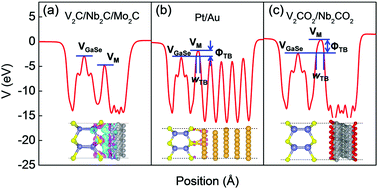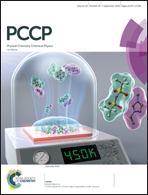Tuning Schottky barriers for monolayer GaSe FETs by exploiting a weak Fermi level pinning effect†
Abstract
Monolayer gallium selenide (GaSe), an emerging two-dimensional semiconductor, holds great promise for electronics and optoelectronics. In reality, the contact properties between a semiconductor and the electrodes play a vital role in device performance. Thus, selecting suitable electrode materials with zero contact resistance is critical and challenging. Here, we explore the contact properties and electronic transport of monolayer GaSe with a series of electrode materials (including transition metals and MXenes) by ab initio electronic calculations and quantum transport simulations. Bare MXenes (V2C, Mo2C, Nb2C) and transition metals (Ni, Cu, Pt, Au) form strong chemical bonds with monolayer GaSe and lead to n-type contacts with Schottky barriers of 0–0.53 eV. The O-terminated MXenes (V2CO2 and Nb2CO2) establish van der Waals interactions with the GaSe sheet and form p-type contacts with vanishing hole Schottky barriers but large tunneling barriers. Impressively, Ohmic contact is achieved by the V2C and Mo2C electrodes, which is further demonstrated by the linear I–V curves. These contact systems exhibit a weak Fermi level pinning effect, with Schottky barriers in both the vertical and lateral directions controllable by the work function of the electrodes. To promote the carrier injection process, we propose to select electrode materials with a strong surface polarization and low work function (<5.0 eV) for GaSe-based devices.



 Please wait while we load your content...
Please wait while we load your content...